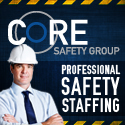| |
Contact Us Archives
Subscribe Printer-Friendly AdvertiseSafety and HealthConstructor Buyers' Guide Facebook 

Top News
Regulatory & Legislative Updates
Events
Chapter News
Best Practices
|
|

AGC's annual Construction Safety Excellence Awards (CSEA) program, sponsored by Willis, has been an ongoing and evolving effort by AGC of America to recognize companies who have developed and implemented excellent safety and loss prevention programs achieved through management committees, employee training and participation, and program innovation.
Now is the time for AGC members to submit their applications for the 14th annual CSEA program.
How to Enter:
All AGC members are encouraged to submit a completed application, using the three-part form supplied by AGC of America. There are two ways to apply: 1) submit completed applications directly to AGC of America, or 2) send forms directly to the appropriate chapter.
Applicants must first contact their “home” chapter to receive information on their established process or procedure. If the process dictates that applicants submit forms to the chapter, they must do so. A $250 entry fee to AGC of America is required upon submission.
Schedules and Deadlines:
• December 10, 2012 .......... Chapters/applicants submit their application to AGC of America.
• January 14 & 15, 2013 ....... Initial Review Judging to determine finalists.
• January 2013 ........................AGC will notify the finalists in each division and category.
• March 4 – 7, 2013 ………….Finalists’ presentations with an independent panel of judges.
• March 8, 2013 …....................Willis-sponsored awards breakfast and ceremony during the AGC 94th Annual Convention in Palm Springs, Calif.
For more information about the AGC/Willis CSEA program and to download the application and instructions/contact list, please visit www.agc.org/csea.
Questions:
Please contact Kevin Cannon, director – safety and health services, at (703) 837-5410 or cannonk@agc.org.


|
By Michael Emmons, Enterprise Fleet Management
Businesses with a fleet of vehicles face a variety of challenges during the winter months. With fewer hours of daylight and more hazardous road conditions caused by rain, sleet, snow or ice, safe driving practices and proper vehicle maintenance can go a long way in controlling costs and increasing efficiencies for drivers and their vehicles. The advantages can include everything from reducing the chances of vehicle collisions, personal injuries, worker compensation claims and downtime to avoiding expensive repairs caused by excessive wear and tear on a vehicle.
In addition to having a good driver training program that includes a written fleet safety policy, it’s important to make sure drivers are familiar with some of the newer emergency icons that may light up on the dashboard to signal problems that need to be addressed. These icons include:
 Traction Control, also called acceleration slip regulation (ASR), is designed to ensure maximum contact between the road surface and the vehicle’s tires when accelerating from a complete stop or speeding up to pass another vehicle, particularly under less-than-ideal road conditions. Traction Control, also called acceleration slip regulation (ASR), is designed to ensure maximum contact between the road surface and the vehicle’s tires when accelerating from a complete stop or speeding up to pass another vehicle, particularly under less-than-ideal road conditions. - Stability Control utilizes speed sensors on each wheel, as well as steering-angle sensors and a hydraulic modulator control to increase traction during potential side-skidding situations.
- Tire Pressure Monitoring System (TPMS) uses pressure-sensing transmitters mounted inside each tire to monitor an unsafe change of 25 percent or more in the air pressure in one or more of a vehicle’s tires.
- Antilock Braking System (ABS) senses and prevents wheel lock-up to improve traction and steering during hard braking. Because the ABS allows drivers to steer while applying maximum braking, there is greater vehicle stability in an emergency and this can make a significant difference in avoiding obstacles.
While it is never a good idea to skip or postpone routine maintenance, it is essential to be vigilant about maintenance in the winter, especially for the following.
- Wipers, Windshield & More. Inspect wiper blades, windshield washers and washer fluid level. Seal any windshield cracks, which tend to spread in the winter. Also check each vehicle’s battery for load capacity and the electrical/charging system, as well as all belts and hoses for softness and wear.
- Tire Replacement. Match dimensions indicated on the tire information decal for new tires to help avoid inaccurate speedometer/odometer readings, ABS brake malfunctions and multiple engine and transmission errors. Some vehicles with all-wheel drive require replacement of all tires at the same time because of potential driveline problems. Consult your owner’s manual or a fleet management professional for additional information.
- Tire Maintenance. Use a quality air pressure gauge to check pressure at least once a week. Correct tire pressure helps extend tire tread life and gas mileage and contributes to good traction and handling. Rotation of the tires, recommended every 10,000 miles, will also extend the tire life further. This is especially true for front wheel drive vehicles.
- Gasoline Selection. Seasonal blends of gasoline will ensure better performance in the winter. Always consult your owner’s manual for recommendations regarding grade or octane of fuel. While gasoline that is too low in octane can drastically affect vehicle performance, higher octane can drive up expenses unnecessarily.
Last but not least, check the vehicle’s emergency roadside kit to make sure it is winter ready. Items may include a cell phone car charger or extra battery, first aid kit, and extra winter clothing, including gloves and boots, as well as a flashlight, tire gauge, fire extinguisher and snow shovel. Even with roadside assistance, being prepared can increase safety, reduce stress and make waiting for assistance more comfortable.
Michael Emmons is a manager in the National Service Department, Fleet Management Division, for Enterprise Fleet Management. As a full-service fleet management business for companies with medium-size fleets, Enterprise supplies most makes and models of cars, light- and medium-duty trucks and service vehicles across North America. For more information about Enterprise Fleet Management’s environmental stewardship and long-term commitment to the sustainability of the fleet management business, visit http://drivingfutures.com/fleetmanagement/. For more information about Enterprise Fleet Management, visit www.efleets.com or call toll free 1-877-23-FLEET.
|
|
|

 2300 Wilson Boulevard, Suite 300 · Arlington, VA 22201 · 703-548-3118 (phone) · 703-548-3119 (fax) · www.agc.org
2300 Wilson Boulevard, Suite 300 · Arlington, VA 22201 · 703-548-3118 (phone) · 703-548-3119 (fax) · www.agc.org
 Submit Your Applications Now for Annual Construction Safety Excellence Awards
Submit Your Applications Now for Annual Construction Safety Excellence Awards




 Traction Control, also called acceleration slip regulation (ASR), is designed to ensure maximum contact between the road surface and the vehicle’s tires when accelerating from a complete stop or speeding up to pass another vehicle, particularly under less-than-ideal road conditions.
Traction Control, also called acceleration slip regulation (ASR), is designed to ensure maximum contact between the road surface and the vehicle’s tires when accelerating from a complete stop or speeding up to pass another vehicle, particularly under less-than-ideal road conditions.